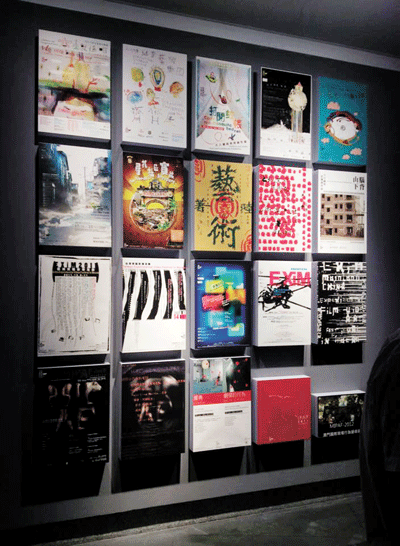 Cao Zhen caozhen0806@126.com HE XIANGNING Art Museum is collaborating with the Shenzhen Fine Art Institute to organize an exhibition showcasing 15 independent art spaces in China and Britain at the Shenzhen Fine Art Institute. The exhibition presents English/Chinese profiles and past project posters, videos and installations featured at various art spaces, including Gland (Beijing), IT Park (Taipei), Shi Jie Zi Museum (Tianshui, Gansu Province), Organhaus Art Space (Chongqing), Ox Warehouse (Macao), Para Site (Hong Kong), the Center for Chinese Contemporary Art (Manchester, U.K.) and am Art Space (Shanghai). According to Feng Boyi, one of the curators of the exhibition, independent art spaces, or alternative spaces, appeared through the spontaneous initiatives of avant-garde artists who wished to emancipate art from the institutional and commercial pressures of the art world. They are nonprofit or not making a profit through artistic activities. “Independent art spaces appeared in the West several decades ago, but in China, they only arrived about 10 years ago. Due to the limitations of ideology and politics, independent art spaces in China face survival challenges. They either exist hand-to-mouth or have been assimilated by the commercial or institutional art systems,” said Feng at a forum early this week at the Shenzhen Fine Art Institute. At the two-day forum, curators from 31 domestic and international independent art spaces and several art critics discussed the status quo and survival of independent art spaces in China, the United Kingdom, India and the Netherlands. The case of Chen Tong’s The Liberia Borges Institut d’Art Contemporain in Guangzhou is a representative example of independent art spaces in China. Founded in 1994, his space currently engages in publishing, recording archives and holding reading salons at his bookstore. His space primarily publishes literary works from France’s Les Editions de Minuit (Midnight Press) as well as philosophical texts. Being a professional painter, Chen said he mainly uses money earned from selling his paintings to run his space. He admitted that using his money is an easy and independent way to support his space because waiting for sponsors to approve funds is time-consuming, but dependence on his money doesn’t go far. “Last year, I organized a performance of Marguerite Duras’ works at my space, free of admission. It attracted many viewers to my bookstore, but if I only sold Duras’ scripts there, not many people would come to buy them, so the performance helped my book sales,” said Chen. Shanghai’s am Art Space founded by artists Yu Ji and Deng Yeming in 2008 carries out international residency programs, workshops, exhibitions, experimental art performances and projects to support young curators. The space is also mainly supported by Yu and Deng’s money, but sometimes from other individuals or organizations. Yu believes that independent art spaces are an important force for balancing commercial and mainstream tendencies in the contemporary art ecosystem, so she insists on using the best of her limited abilities to promote independent and experimental value, not heavily relying on funds from other sources. Compared to Chinese spaces, which live on chicken feed, curators of independent art spaces in the West might be enviable by their Chinese counterparts because they have access to coveted funds and think more about their future improvement. Sarah Perks, artistic director of HOME in Manchester, said HOME is funded by the Manchester City Council, Arts Council England and other public/corporate funds and patrons. As a part of the development of a creative quarter in Manchester, HOME has a 500-seat theater, a 150-seat flexible studio space, five cinema screens and a 500-square-meter gallery. Perks said HOME is independent from a board of trustees who do not interfere with their programs. However, she also admitted that government funding is not stable because of European austerity measures. Michel van Dartel, senior curator at V2_Institute for the Unstable Media in Rotterdam, felt the same pinch. He said funding from the government has shrunk, so they now use social media to seek support. The curators all agree that although independent art spaces are on the fringe, they play a unique and dynamic role in the overall contemporary art system and the ideal condition for them is financial independence. “Despite the fluid interpretation of independence, it’s important that we insist artists have options to be creative and open-minded and independent art spaces should maintain a cynical approach to arts ecology and attitudes. Audiences also have choices,” said Perks. The forum will continue to be held at the Center for Chinese Contemporary Art in Manchester and will be held at the Ullens Center for Contemporary Art in Beijing in December. It will explore the survival strategies and modes of existence of independent art spaces in all forms from around the world, probing artists’ conditions and challenges while emphasizing and promoting the free and independent attitudes and viewpoints of the space. Dates: Until Nov. 5 Hours: 9 a.m.-5 p.m. Closed Mondays Venue: Shenzhen Fine Art Institute, 36 Jinhu Street 1, Yinhu Road, Luohu District (罗湖区银湖路金湖一街36号深圳画院) Metro: Longhua Line, Lianhua North Station (莲花北站), Exit A1, and then take a taxi for a 10-minute ride | 
